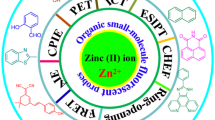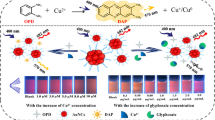Abstract
We constructed a novel-binding site for metal ion detection using a fused tetrazole ring conjugated with aminopyrene (R). The designed structure of the molecule was successfully synthesized and determined the probe's selectivity by testing various metal ions and found that the probe effectively detects Al3+ ion visually. Checked the sensing ability of the probe with different approaches (fluorimetric and colorimetric), and the effectiveness is double confirmed. The added Al3+ ion to R procured a rapid change in color from yellowish orange to colorless. Under the UV lamp, a turn-on blue fluorescence was observed after adding aluminium ion, whereas the probe was non-fluorescent before detecting aluminium ion. The probable interface of the probe with aluminium ion has also been expected from HRMS spectral analysis results. The probe's utility in real-time monitoring of Al3+ ion in water is confirmed by a simple test kit prepared using filter paper. The kit showed a possible naked-eye detection with a notable color change, and when checked, the aluminium ion detected test kit under a UV lamp showed blue fluorescence.












Similar content being viewed by others
Availability of Data and Material
All data available.
Code Availability
Not applicable.
References
Anamika D, Atanu J, Nikhil G, Prasanta G, Susanta KK (2014) Rhodamine-based molecular clips for highly selective recognition of Al3+ ions: synthesis, crystal structure and spectroscopic properties. New J Chem 38:1627–1634
Long F, **g CQ, Chao RL, Zheng YY (2019) A Schiff-base receptor based chromone derivate: Highly selective fluorescent and colorimetric probe for Al(III). Spectrochim Acta A Mol Biomol Spectrosc 218:342–347
Dong M, Dong YM, Ma TH, Wang YW, Peng Y (2012) A highly selective fluorescence enhanced chemosensor for Al3+ in aqueous solution based on a hybrid ligand from BINOL scaffold and β-amino alcohol. Inorg Chim Acta 381:137–142
Gui SL, Huang YY, Hu F, ** YL, Zhang GX, Yan LS, Zhang DQ, Zhao R (2015) Fluorescence turn-on chemosensor for highly selective and sensitive detection and bioimaging of Al3+ in living cells based on ion-induced aggregation. Anal Chem 87:1470–1474
Kim S, Noh JY, Kim KY, Kim JH, Kang HK, Nam SW, Kim SH, Park S, Kim C, Kim J (2012) Salicylimine-based fluorescent chemosensor for aluminum ions and application to bioimaging. Inorg Chem 51:3597–3602
**e HT, Wu YL, Huang J (2016) A ratiometric fluorescent probe for aluminum ions based-on monomer/excimer conversion and its applications to real samples. Talanta 151:8–13
Yue XL, Li CR, Yang ZY (2017) A novel Schiff-base fluorescent probe based on 1,8- naphthyridine and naphthalimide for Al3+. Inorg Chim Acta 464:167–171
Animesh S, Arnab B, Sisir L, Avishek B, Subhra KM, Damir AS, Maria GB, Michael B, Yann G, Debasis D (2013) FRET Based Tri-Color Emissive Rhodamine-Pyrene Conjugate as an Al3+ Selective Colorimetric and Fluorescence Sensor for Living Cell Imaging. Dalton Trans 42:13311–13314
Virk SA, Eslick GD (2015) Meta-analysis of antacid use and Alzheimer’s disease implications for the aluminum hypothesis. Epidemiology 26:769–773
Bjorklund G, Stejskal V, Urbina MA, Dadar M, Chirumbolo S, Mutter J (2018) Parkinson’s disease: mechanisms and biochemical processes. Curr Med Chem 25:2198–2214
Martinez CS, Piagette JT, Escobar AG, Martin A, Palacios R, Peçanha FM, Vassallo DV, Exley C, Alonso MJ, Miguel M, Salaices M, Wiggers GA (2017) Aluminum exposure at human dietary levels promotes vascular dysfunction and increases blood pressure in rats: a concerted action of NAD(P)H oxidase and COX-2. Toxicology 390:10–21
Manjunath R, Kannan P (2018) Highly selective rhodamine-based fluorescence turn-on chemosensor for Al3+ ion. Opt Mater 79:38–44
Sahoo SK, Sharma D, Bera RK, Crisponic G, Callan JF (2012) Iron(III) selective molecular and supramolecular fluorescent probes. Chem Soc Rev 41:7195–7227
Sivaraman G, Iniya M, Anand T, Kotla NG, Sunnapu O, Singaravadivel S, Gulyani A, Chellapp D (2018) Chemically diverse small molecule fluorescent chemosensors for copper ion. Coord Chem Rev 357:50–104
Liu M, Yu X, Li M, Liao NX, Bi AY, Jiang YP, Liu S, Gong ZC, Zeng WB (2018) Fluorescent probes for the detection of magnesium ions (Mg2+): from design to application. RSC Adv 8:12573–12587
Wu D, Sedgwick AC, Gunnlaugsson T, Akkaya EU, Yoon JY, James TD (2017) Fluorescent chemosensors: the past, present and future. Chem Soc Rev 46:7105–7123
Meng XJ, Li SL, Ma WB, Wang JL, Hu ZY, Cao DL (2018) Highly sensitive and selective chemosensor for Cu2+ and H2PO4- based on coumarin fluorophore. Dyes Pigments 154:194–198
Borase PN, Thale PB, Sahoo SK, Shankarling GS (2015) An “off-on” colorimetric chemosensor for selective detection of Al3+, Cr3+ and Fe3+: Its application in molecular logic gate. Sens Actuators B Chem 215:451–458
Kejik Z, Kaplanek R, Havlik M, Briza T, Vavrinova D, Dolensky B, Martasek P, Kral V (2016) Aluminium(III) sensing by pyridoxal hydrazone utilising the chelation enhanced fluorescence effect. J Lumin 180:269–277
Zhu J, Zhang Y, Wang L, Sun T, Wang M, Wang Y, Ma D, Yang Q, Tang Y (2016) A simple turn-on Schiff base fluorescence sensor for aluminum ion. Tetrahedron Lett 57:3535–3539
Li CY, Zhou Y, Li YF, Zou CX, Kong XF (2013) Efficient FRET-based colorimetric and ratiometric fluorescent chemosensor for Al3+ in living cells. Sens Actuators B Chem 186:360–366
Yue XL, Wang ZQ, Li CR, Yang ZY (2017) Naphthalene-derived Al3+ - selective fluorescent chemosensor based on PET and ESIPT in aqueous solution. Tetrahedron Lett 58:4532–4537
Wang B, Fu T, Yang S, Li J, Chen Y (2013) An intramolecular charge transfer (ICT)- based dual emission fluorescent probe for the ratiometric detection of gold ions. Anal Methods 5:3639–3641
Li Q, Cai Y, Yao H, Lin Q, Zhu YR, Li H, Zhang YM, Wei TB (2015) A colorimetric and fluorescent cyanide chemosensor based on dicyanovinyl derivatives: utilization of the mechanism of intramolecular charge transfer blocking. Spectrochim Acta A Mol Biomol Spectrosc 136:1047–1051
Torawane P, Tayade K, Bothra S, Sahoo SK, Singh N, Borse A, Kuwar A (2016) A highly selective and sensitive fluorescent ‘turn-on’ chemosensor for Al3+ based on C=N isomerisation mechanism with nanomolar detection. Sens Actuators B Chem 222:562–566
Heo G, Manivannan R, Kim H, Son YA (2019) Liquid and gaseous state visual detection of chemical warfare agent mimic DCP by optical sensor. Dyes Pigments 171:107712
Heo G, Manivannan R, Kim H, Kim MJ, Min KS, Son YA (2019) Develo** an RGB - Arduino device for the multi-color recognition, detection and determination of Fe(III), Co(II), Hg(II) and Sn(II) in aqueous media by a terpyridine moiety. Sens Actuators B Chem 297:126723
Kim IJ, Manivannan R, Son YA (2017) A reaction based colorimetric chemosensor for the detection of cyanide ion in aqueous solution. Sens Actuators B Chem 246:319–326
Park JH, Manivannan R, Jayasudha P, Son YA (2020) Selective detection of cyanide ion in 100 % water by indolium based dual reactive binding site optical sensor. J Photochem Photobiol A Chem 397:112571
Manivannan R, Lee HS, Son YA (2022) Simple easy to make xanthene based optical probe for solid and liquid state Hg2+ ion detection. Spectrochim Acta A Mol Biomol Spectrosc 266:120413
Shelar DP, Birari DR, Rote RV, Patil SR, Toche RB, Jachak MN (2011) Novel Synthesis of 2-aminoquinoline-3-carbaldehyde, benzo[b][1,8]naphthyridines and Study of their Fluorescence Behavior. J Phys Org Chem 24:203–211
Ryu J, Manivannan R, Son YA (2021) Azo dye-based optical probe for the detection toward mimic molecule of date rape drug. Microchem J 166:106237
Kim H, Manivannan R, Son YA (2020) A chromone based fluorescent probe for the effective detection of aluminium ion. J Nanosci Nanotechnol 20:2840–2846
Ma J, Liu Y, Chen L, **e Y, Wang LY, **e MX (2012) Spectroscopic investigation on the interaction of 3,7-dihydroxyflavone with different isomers of human serum albumin. Food Chem 132:663–670
Manivannan R, Ryu J, Son YA (2021) DPP based dual-sensing probe for the multi-color detection of toxic Co2+/Sn2+ and CN- ions in water: An electronic eye development. Dyes Pigments 192:109425
Kim MJ, Manivannan R, Kim IJ, Son YA (2017) A colorimetric and fluorometric chemosensor for the selective detection of cyanide ion in both the aqueous and solid phase. Sens Actuators B Chem 253:942–948
Park JH, Manivannan R, Jayasudha P, Son YA (2020) Spontaneous optical response towards cyanide ion in water by a reactive binding site probe. Spectrochim Acta A Mol Biomol Spectrosc 233:118190
Min KS, Manivannan R, Son YA (2018) Rhodamine-fluorene based dual channel probe for the detection of Hg2+ ions and its application in digital printing. Sens Actuators B Chem 261:545–552
Hung PJ, Chir JL, Ting W, Wu AT (2015) A selective colorimetric and ratiometric fluorescent chemosensor for detection of Al3+ ion. J Lumin 158:371–375
Qin JC, Li TR, Wang BD, Yang ZY, Fan L (2014) A sensor for selective detection of Al3+ based on quinoline Schiff-base in aqueous media. Synth Met 195:141–146
Zhao YH, Zeng X, Mu L, Li J, Redshaw C, Wei G (2014) A reversible and visible colorimetric/fluorescent chemosensor for Al3+ and F- ions with a large Stoke’s shift. Sens Actuators B Chem 204:450–458
Tian L, Xue J, Yang ZY (2018) A simple quinoline derivative as fluorescent probe with high sensitivity and selectivity for Al3+ in aqueous solution. Tetrahedron Lett 59:4110–4115
Park HM, Oh BN, Kim JH, Qiong W, Hwang IH, Jung KD, Kim C, Kim J (2011) Fluorescent chemosensor based-on naphthol-quinoline for selective detection of aluminum ions. Tetrahedron Lett 52:5581–5584
Liao ZC, Yang ZY, Li Y, Wang BD, Zhou Q-X (2013) A simple structure fluorescent chemosensor for high selectivity and sensitivity of aluminum ions. Dyes Pigment 97:124–128
Guo Z, Niu Q, Li T (2018) Highly sensitive oligothiophene-phenylamine-based dual-functional fluorescence “turn-on” sensor for rapid and simultaneous detection of Al3+ and Fe3+ in environment and food samples. Spectrochim Acta A Mol Biomol Spectrosc 200:76–84
Celestina JJ, Alphonse L, Tharmaraj P, Sheela CD (2019) Novel triazine-based colorimetric and fluorescent sensor for highly selective detection of Al3+. J Sci Adv Mater Dev 4:237–244
Frisch MJ, Trucks GW, Schlegel HB, Scuseria GE, Robb MA, Cheeseman JR, Jr Montgomery JA, Vreven T, Kudin KN, Burant JC, Millam JM, Iyengar SS, Tomasi J, Barone V, Mennucci B, Cossi M, Scalmani G, Rega N, Petersson GA, Nakatsuji H, Hada M, Ehara M, Toyota K, Fukuda R, Hasegawa J, Zshida M, Nakajima T, Honda Y, Kitao O, Nakai H, Klene M, Li X, Knox JE, Hratchian HP, Cross JB, Bakken V, Adamo C, Jaramillo J, Gomperts R, Stratmann RE, Yazyev O, Austin AJ, Cammi R, Pomelli C, Ochterski JW, Ayala PY, Morokuma K, Voth GA, Salvador P, Dannenberg JJ, Zakrzewski VG, Dapprich S, Daniels AD, Strain MC, Farkas O, Malick DK, Rabuck AD, Raghavachari K, Foresman JB, Ortiz JV, Cui Q, Baboul AG, Clifford S, Cioslowski J, Stefanov BB, Liu G, Liashenko A, Piskorz P, Komaromi I, Martin RL, Fox DJ, Keith T, Al-Laham MA, Peng CY, Nanayakkara A, Challacombe M, Gill PMW, Johnson B, Chen W, Wong MW, Gonzalez C, Pople JA (2004) Gaussian, 09, Revision D.01. Gaussian, Inc., Wallingford CT
Acknowledgements
The authors are grateful to Chungnam National University for the support of this work.
Funding
This research was supported by Chungnam National University.
Author information
Authors and Affiliations
Contributions
All the authors (Ramalingam Manivannan, Young-A Son) made substantial contribution in preparing the manuscript.
Corresponding author
Ethics declarations
Ethics Approval
Not applicable.
Consent to Participate
Informed consent obtained from all individual participants included in the study.
Consent for Publication
Not applicable.
Conflicts of Interest/Competing Interests
The authors declare that they have no conflict of interest.
Additional information
Publisher's Note
Springer Nature remains neutral with regard to jurisdictional claims in published maps and institutional affiliations.
Supplementary Information
Below is the link to the electronic supplementary material.
Rights and permissions
About this article
Cite this article
Manivannan, R., Son, YA. A Pyrene-Tetrazole Fused Fluorescent Probe for Effective Real Time Detection Towards Aluminium Ion. J Fluoresc 32, 1703–1712 (2022). https://doi.org/10.1007/s10895-022-02985-4
Received:
Accepted:
Published:
Issue Date:
DOI: https://doi.org/10.1007/s10895-022-02985-4




